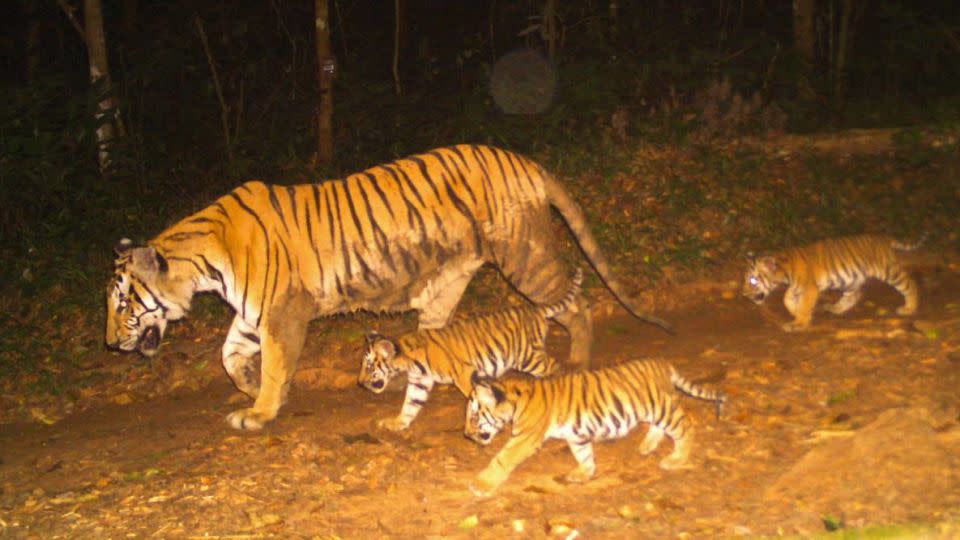Tigers are disappearing from Southeast Asia. A forest in Thailand is offering new hope
Editor’s Note: Call to Earth is a CNN editorial series committed to reporting on the environmental challenges facing our planet, together with the solutions. Rolex’s Perpetual Planet Initiative has partnered with CNN to drive awareness and education around key sustainability issues and to inspire positive action.
As Global Tiger Day rolls around, there’s good news for the big cats in Thailand.
The tiger population in the country’s Western Forest Complex (WEFCOM) — an 18,000-square-kilometer (6,950-square-mile) area of forest encompassing 11 national parks and six wildlife sanctuaries — is estimated to have more than tripled between 2007 and 2023, from 41 to 143.
The remarkable comeback was observed in a new collaborative study led by Thailand’s Department of National Parks (DNP) and the Wildlife Conservation Society (WCS), newly published online in the scientific journal Global Ecology and Conservation.
It’s not just tigers bouncing back: a companion study, published alongside the tiger assessment, found that populations of threatened ungulate species — hoofed mammals like deer and wild cattle, that are the main prey for the tigers — have doubled in Huai Kha Khaeng Wildlife Sanctuary, one of three protected areas, along with Thung Yai East (TYE) and Thung Yai West, in the forest complex.
This increase reflects “more effective management” of the forest and is the result of more than a decade of conservation interventions, says Pornkamol Jornburom, director of WCS Thailand and one of the wildlife biologists working on the new study.
“This forest complex is the home of many endangered species,” says Jornburom. She hopes WEFCOM can be “a role model for conservation and recovery of the wildlife population.”
A roaring success
Jornburom, who has worked on conservation projects in WEFCOM since 2005, says that she’s seen the landscape change dramatically.
One of the biggest threats to wildlife in the area is poaching, which is best combated with patrols. In 2005, these were limited in number and not systematic, says Jornburom, adding that rangers “would maybe report back to their managers verbally, so there was no data collection or recordings.”
But WEFCOM — the biggest forest area in Thailand, and the largest forest track in mainland Southeast Asia, according to WCS — is a hugely important habitat, not just for tigers, but endangered animals including Asian elephants, hornbills, and banteng. The complex has a huge diversity of species too: 150 mammals, 490 birds and 90 reptiles.
It’s also a relatively uncommon landscape in the region. Most tiger conservation focuses on protecting small, isolated areas, but WEFCOM connects multiple national parks and protected areas through forest corridors across a wide expanse — vital for tigers, which require up to 300 square kilometers (115 square miles) of habitat to roam.

The DNP began working with WCS to “build and strengthen site-based protection,” says Jornburom. Patrol teams began using GPS to precisely identify locations, and a standardized reporting form to collect data has helped to identify patrol routes, distribution of wildlife, and sites of illegal activity.
In 2007, conservationists installed camera traps which built up a data set that researchers could use for their population assessment in the current study across the three main protected areas. Individual tigers can be identified by their unique stripes, similar to a human fingerprint.
Jornburom says the 250% increase in tigers, as well as the twofold increase in banteng and sambar deer, is proof that the increased patrols are working.
“When we conserve tigers, it actually leads to conserving many other species: not only the prey, but also the habitat,” she says.
A ‘conservation-dependent species’
While Thailand’s success story offers hope, the outlook across the region is not so optimistic.
Once widespread across Southeast Asia, tigers became extinct in Singapore, Java and Bali in the 20th century, and in recent years have also disappeared from Vietnam, Laos and Cambodia in the wild.
This has left small, isolated tiger populations in Myanmar, Indonesian Sumatra, and peninsular Malaysia — the latter of which is worrying conservationists after a recent spate of tiger deaths.
Tigers are a “conservation-dependent species” that require constant interventions to protect them from the threat of hunting and poaching, says Stuart Chapman, leader of WWF’s Tigers Alive Initiative. In Southeast Asia, their numbers are so low that they’ve reached a “tipping point” where accidents, disease or conflict can cause populations to go extinct, he adds.
“Every tiger counts, particularly when populations get to such low levels that recovery then depends on no additional threats coming in that can potentially wipe them out,” says Chapman.
Chapman, who was not part of the study, says that the research from WEFCOM is a “historic” moment for the species, and shows that “with good habitat management and healthy prey populations, results are possible.”
“Thailand, after decades of sustained conservation effort, has produced this result, and it is extraordinary,” says Chapman.
According to the DNP’s most recent survey, there are an estimated 179 to 223 adult tigers in the wild in Thailand, up from 148 to 189 tigers in 2022.
WEFCOM currently boasts most of the country’s tiger population, and has the potential to support up to 2,000 tigers, according to WCS. However, this depends on factors like effective protection, prey availability, and community engagement, says Jornburom, adding: “We also need more technology to help and support the (rangers) on the ground.”
She is optimistic that with more patrols and funding, the population in WEFCOM can continue to grow — and hopes that other national parks will adopt the model to save their tiger populations too.
“I think it’s a very inspiring model of intervention for other landscapes and protected areas — not only in Thailand, but also our neighboring countries.”
For more CNN news and newsletters create an account at CNN.com

